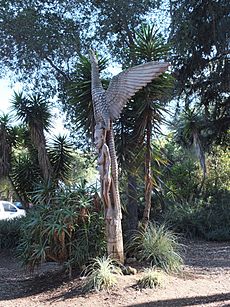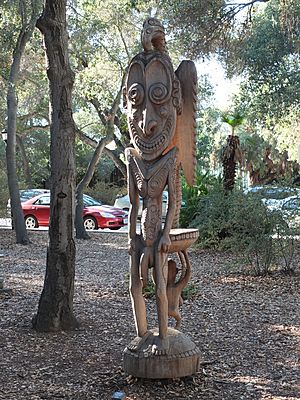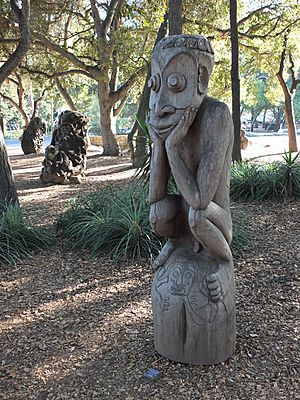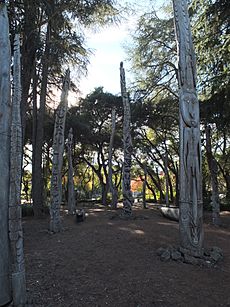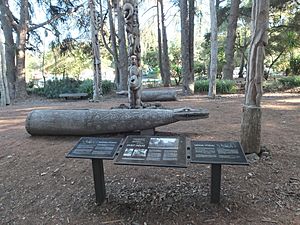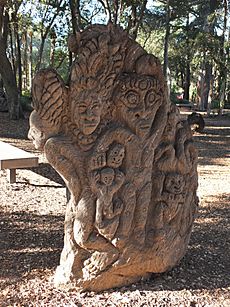Papua New Guinea Sculpture Garden facts for kids
The New Guinea Sculpture Garden is a special outdoor art display at Stanford University in California. It was created in 1994 by two groups of talented carvers from the Sepik River region of Papua New Guinea. These artists came from the Iatmul people and the Kwoma people.
The garden is located in a peaceful, wooded area on the Stanford campus, right next to a student dormitory. It features amazing sculptures made from wood and stone. The garden also has special plants and landscaping designed to look like the Sepik River environment. This includes areas that remind visitors of the riverbanks and the open spaces in front of important meeting houses (called men's houses) in Sepik villages.
Contents
What is the Garden?
The entrance to the garden feels like the wide, open floodplains of the Sepik River. As you walk further in, you enter a "forest" of sculptures and trees. This part of the garden is designed to feel like a grand Sepik cult house, which is a very important building in their culture.
The garden is divided into four main areas. Near the entrance, you'll see a large wooden eagle sitting on the shoulders of an ancestress figure. This eagle looks like the decorations often found on top of Iatmul cult houses. Behind it, there's a group of about twelve very tall wooden poles. These poles are carved with beautiful and detailed designs from both Iatmul and Kwoma traditions.
Another section has brightly painted Kwoma poles. The third area is unique because it features large sculptures made from pumice stone. This was a new material for the carvers, as stone is not common in their home region. At night, special lights on the ground make the sculptures glow, creating a magical atmosphere.
The Amazing Sculptures
Many of the stone sculptures in the garden show creatures from Sepik myths. Some of these were inspired by Western sculptures found elsewhere on the Stanford campus. The carved wooden poles often mix traditional designs with modern ideas. For example, you might see ancestress figures wearing grass skirts.
Many carvings follow the natural shape of the wood, making them look very three-dimensional. This was a new way of carving for the Sepik artists. One interesting piece is a mostly bare pole, which only hints at the sculpture it could have become. This piece shows that art is a process, and interpretations can always change. The garden beautifully explores ideas like light and shadow, and how nature and culture come together.
How the Garden Was Made
Creating the garden was a huge project! A student named Jim Mason helped organize everything. He raised money from many different people and groups. For example, some people sponsored plants or benches. Large companies like Bechtel and Chevron, and even Airnuigini (Papua New Guinea's national airline), also helped. Stanford University gave the garden a permanent home.
Jim Mason arranged for special hardwood trees to be brought to the campus from Asia. The ten woodcarvers flew all the way from the Sepik River to California, traveling through Hong Kong. This was a much longer journey than any of them had ever taken before!
Once they arrived, the carvers were treated like celebrities in Palo Alto and at Stanford. They attended special dinners and even performed with African-American drummers. The carvers were in California on a six-month educational visa. During their stay, local people, groups, and businesses gave them food, medical care, clothes, transportation, and even a trip to Disneyland! One of the Iatmul artists, Teddy Balangu, later became an artist-in-residence at the Museum of Anthropology at UBC in Canada.
Artists, Not Just Carvers
A main goal of this project was to show the carvers as true "artists" with amazing talent. In the past, art from places like Melanesia (where Papua New Guinea is) was sometimes seen as less important than Western art. By calling these men "master carvers," the project helped people see their work as valuable and unique art, just like any other masterpiece.
However, in Iatmul society, there isn't a specific title like "master carver." So, in a way, the garden used a Western idea to help Western people appreciate non-Western art. This mix of cultures and ideas is one of the most interesting parts of the sculpture garden.
The project wasn't trying to perfectly copy a traditional Melanesian village. Instead, it aimed to let the carvers try new things and share their art in a Western public space. The hope was that the carvers would blend their traditional Sepik River themes with modern art ideas, like showing individual feelings and creating art just for people to admire. This gave the artists a chance to create art that might not have been possible in their home villages.
The success of the garden came from combining different cultural ideas: Melanesian and Western, traditional and modern, art and culture. The artists were brought to Stanford because of their Papua New Guinean background, but once there, they were encouraged to think of themselves as artists first. They also had a lot of say in how their art was displayed, which is rare in museums. Each sculpture even has the artist's name on it, highlighting their individual talent.
Interactive Experiences
During the six months the artists were there, many public events took place. These included daily tours of the site, bamboo flute performances by the carvers, public talks, and "story-time" sessions with the artists. There were also programs for school children, like on-site bark painting. These activities helped people connect with the artists and their work.
Two sculptures that got a lot of attention were carvings that looked like famous works by the Western sculptor Rodin: The Thinker and The Gates of Hell. Both were carved by two Iatmul men from Tambunum village. One of the artists, Simon, reportedly thought, "I can do this - even better!" when he saw Rodin's The Thinker at the Cantor Arts Center on campus.
The Papua New Guinea Sculpture Garden even has its own Facebook page!
Visiting the Garden
The Cantor Arts Center offers tours of the Papua New Guinea Sculpture Garden. These tours happen on the third Sunday of every month at 2:00 PM, rain or shine. You can meet at the corner of Santa Teresa and Lomita Drive. The tours explain how the garden was created on-site by artists from Papua New Guinea. You'll learn about the wood and stone carvings of people, animals, and magical beings that tell clan stories and creation myths.
Images for kids



